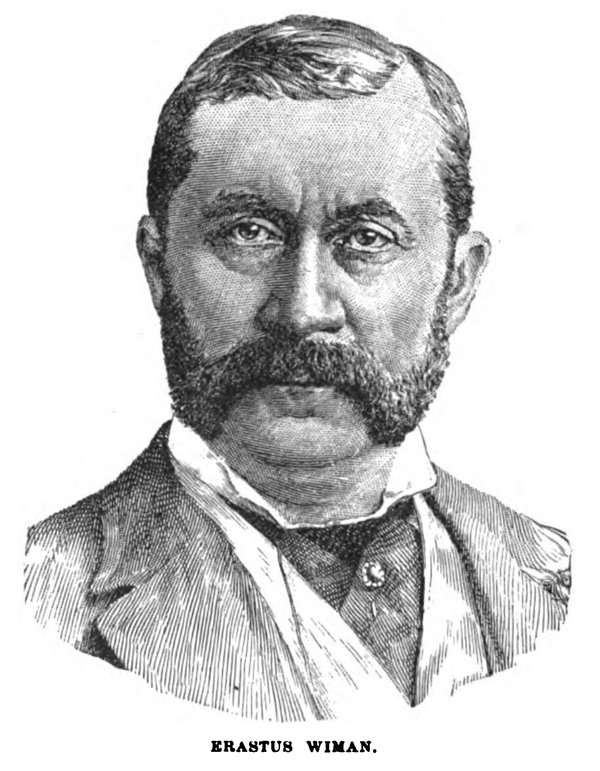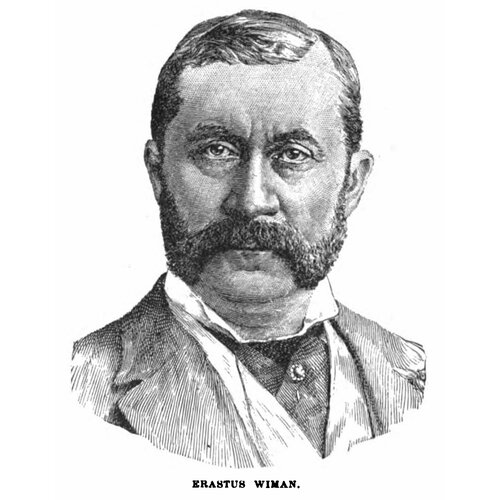
Source: Courtesy of Wikimedia Commons
WIMAN, ERASTUS, businessman, promoter, and author; b. 21 April 1834 in Churchville, Toronto Township, Upper Canada, son of Erastus Wiman; m. 1860 Eleanor Anne Galbraith, and they had three sons and two daughters; d. 9 Feb. 1904 in St George, Staten Island, N.Y.
Erastus Wiman’s father died in September 1834, leaving his wife to care for their only living child. Young Wiman received some formal education in Toronto and in his early teens he worked there as a newsboy. At age 16 he became a printer’s apprentice to his cousin William McDougall, managing editor of the North American. When this journal amalgamated with the Globe in 1855, Wiman was employed by its owner, George Brown*. He soon became the paper’s commercial editor. In 1856, evidently with McDougall, he founded a book-and news-store and set up a publishing company. Among the works Wiman would edit or publish over the next nine years were the Grumbler (a humorous weekly), the Canadian Agriculturist, the Market Review and Weekly Price Current, and the Annual report of the Toronto Board of Trade. In 1859 he sat as a councillor for St Andrew’s Ward.
Wiman’s skill as a commercial editor attracted the attention of Robert Graham Dun, president of an American mercantile reporting agency, who appointed him manager of the Toronto office of R. G. Dun and Company in 1860. Two years later Wiman moved to Montreal as manager of the firm for all of Canada; in 1865 he edited the Montreal Trade Review. In 1866 he was transferred as a partner to his firm’s head office, Dun, Barlow and Company in New York City. When Charles Barlow died in 1880, his interest was acquired by Wiman, who became general manager. Wiman quickly prospered and soon was earning $90,000 a year. He maintained interest in Canada principally as president of the Great North Western Telegraph Company of Canada, which he organized with American capitalist Jay Gould in 1882.
A socialite who loved fast horses, Wiman lived with his close-knit family in a grand house on Staten Island. The business enterprise dearest to his heart was the development of the island as New York’s transport hub, in competition with Manhattan. By the mid 1880s he had wrested control of the ferry service to the island from the Vanderbilt interests, acquired ten miles of shoreline for the development of a harbour, built a railway round the island, and opened an amusement park. In partnership with Robert Garrett, president of the Baltimore and Ohio Railroad, he constructed a railway bridge to New Jersey, thus providing direct access to trunk lines.
After Garrett’s resignation as president in 1887, interests hostile to Wiman’s plans took control of the railway and Wiman’s association with it turned sour. At the time he was said to be worth between two and three million dollars, but his capital was mainly tied up in his Staten Island ventures, whose value collapsed. By 1893, a year of financial crisis in the United States, Wiman was in trouble. His island properties were placed in assignment, and he was ousted from the Dun firm.
In 1894 Dun laid charges of forgery against Wiman. He was found guilty, but the verdict was overturned in 1896. The following year, after finally taking out United States citizenship, he ran unsuccessfully as a councilman for greater New York. No longer the “Duke of Staten Island,” he lived out his last years in straitened circumstances. In 1901 he suffered a stroke from which he never completely recovered. Just before his death in 1904, his home was sold for a fraction of its worth.
Wiman had maintained a keen interest in Canada. In his palmy days, he gave generously to Canadian friends, built the Wiman Baths on Toronto Island (1882), lent financial support to the Montreal winter carnival, and tried to make himself useful to the federal government of Sir John A. Macdonald*. Founder in 1885 and first president of the Canadian Club in New York City, he promoted lacrosse and cricket there by bringing in Canadian teams for matches.
His most prominent Canadian venture was the promotion from 1887 of a commercial union of Canada and the United States. The scheme involved the abolition of tariffs between the two nations, the creation of a common tariff against the rest of the world, and the pooling of the customs revenues of both countries and their distribution on the basis of population. Commercial union was supported in the United States by some prominent businessmen of the protectionist persuasion (among them Samuel J. Ritchie, with whom Wiman shared interests in Canadian resources) and by a few members of Congress from states bordering on Canada. In the dominion the scheme won the backing of farmers’ groups in Ontario, several Liberal papers, and some leading figures in the Liberal party, including Sir Richard John Cartwright* and John Charlton. Thrice defeated in elections on the tariff question, the party was desperately looking for a new trade policy in 1887–88. However, the political implications of commercial union – the thin end of the wedge of annexation – troubled many members. In 1888 the party embraced unrestricted reciprocity, but in 1891 the Conservatives, charging that this policy was treasonous, defeated the Liberals yet again.
Wiman wrote many pamphlets and gave dozens of speeches in Canada and the United States advocating commercial union. Authorities differ on whether he supported the next logical step in continentalist thought, annexation, which was briefly promoted by some Canadian commercial unionists after the Conservative victory. “As for the present there is no possibility that Canada can be brought into the national life [of the United States],” Wiman wrote in his book Chances of success in 1893. By then, with his own fortune in eclipse, commercial union (and unrestricted reciprocity) was a dead issue in Canada. Ian Grant, Wiman’s closest student, records that he “failed to comprehend how determined Canadians had been traditionally to develop a separate identity, free from American infringements or coercion. Wiman was too Americanized by 1887 to appreciate this fact.”
Erastus Wiman’s Chances of success: episodes and observations in the life of a busy man was issued in Toronto and New York in 1893. Wiman also published various speeches and pamphlets, listings for which appear in Canadiana, 1867–1900; CIHM Reg.; and NA, Catalogue of pamphlets . . . , comp. Magdalen Casey (2v., Ottawa, 1932), 2.
Monetary Times, 12 Feb. 1904: 1062. New York Times, 10 Feb. 1904: 7. New York Tribune, 10 Feb. 1904. Christopher Armstrong and H. V. Nelles, Monopoly’s moment: the organization and regulation of Canadian utilities, 1830–1930 (Philadelphia, 1986). R. C. Brown, Canada’s National Policy, 1883–1900: a study in Canadian-American relations (Princeton, N.J., 1964); “The commercial unionists in Canada and the United States,” CHA Report, 1963: 116–24. Canada, an encyclopædia (Hopkins), vol.1. Canadian men and women of the time (Morgan; 1898). Death notices of Ont. (Reid). Dict. of Toronto printers (Hulse). Ian Grant, “Erastus Wiman: a continentalist replies to Canadian imperialism,” CHR, 53 (1972): 1–20. Elgin Myers, “A Canadian in New York,” Canadian Magazine, 1 (March-October 1893): 435–43. Naylor, Hist. of Canadian business. J. D. Norris, R. G. Dun & Co., 1894–1900: the development of credit-reporting in the nineteenth century (Westport, Conn., and London, 1978). Who was who in America . . . 1897–1942 (Chicago, 1943).
Cite This Article
Robert Craig Brown, “WIMAN, ERASTUS,” in Dictionary of Canadian Biography, vol. 13, University of Toronto/Université Laval, 2003–, accessed April 2, 2025, https://www.biographi.ca/en/bio/wiman_erastus_13E.html.
The citation above shows the format for footnotes and endnotes according to the Chicago manual of style (16th edition). Information to be used in other citation formats:
| Permalink: | https://www.biographi.ca/en/bio/wiman_erastus_13E.html |
| Author of Article: | Robert Craig Brown |
| Title of Article: | WIMAN, ERASTUS |
| Publication Name: | Dictionary of Canadian Biography, vol. 13 |
| Publisher: | University of Toronto/Université Laval |
| Year of revision: | 1994 |
| Access Date: | April 2, 2025 |



